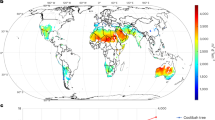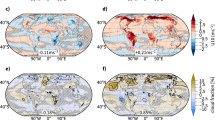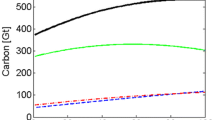Abstract
Each year, irrigated Saharan- and Australian-desert forests could sequester amounts of atmospheric CO2 at least equal to that from burning fossil fuels. Without any rain, to capture CO2 produced from gasoline requires adding about $1 to the per-gallon pump-price to cover irrigation costs, using reverse osmosis (RO), desalinated, sea water. Such mature technology is economically competitive with the currently favored, untested, power-plant Carbon Capture (and deep underground, or under-ocean) Sequestration (CCS). Afforestation sequesters CO2, mostly as easily stored wood, both from distributed sources (automotive, aviation, etc., that CCS cannot address) and from power plants. Climatological feasibility and sustainability of such irrigated forests, and their potential global impacts are explored using a general circulation model (GCM). Biogeophysical feedback is shown to stimulate considerable rainfall over these forests, reducing desalination and irrigation costs; economic value of marketed, renewable, forest biomass, further reduces costs; and separately, energy conservation also reduces the size of the required forests and therefore their total capital and operating costs. The few negative climate impacts outside of the forests are discussed, with caveats. If confirmed with other GCMs, such irrigated, subtropical afforestation probably provides the best, near-term route to complete control of green-house-gas-induced, global warming.
Article PDF
Similar content being viewed by others
Avoid common mistakes on your manuscript.
References
Abu-Zeid K, Wagdy A, Elbadawy O, Abdel-Meguid A (2004) State of the water in the Arab region. CEDARE, http://www.idrc.ca/uploads/user-S/11114806841arabstatewater1.pdf
Allen RJ (1983) Monsoon and teleconnection variability over Australasia during the southern hemisphere summers of 1973–77. Mon Weather Rev 111:113–142
Alley R et al (2007) IPCC summary for policy makers. IPCC Secretariat, Geneva, http://www.ipcc.ch
Anthes RA (1984) Enhancement of convective precipitation by mesoscale variations in vegetative covering in semiarid regions. J Clim Appl Meteorol 23:541–554
Anthes RA (1993) The global trajectory. Bul Am Meteo Soc 74:1121–1130, http://www.ucar.edu/pres/traject.html
Axtell RL, McRae GJ (2006) Changing how we discount to make public policy more responsive to citizens’ time preferences. Regulatory Analysis 06-01 AEI Brookings Joint Center for Regulatory Studies, http://www.aei-brookings.org/publications/abstract.php?pid=1049
Bala G, Caldeira K, Wickett M, Phillips TJ, Lobell DB, Delire C, Mirin A (2007) Combined climate and carbon-cycle effects of large-scale deforestation. Proc Natl Acad Sci 104:6550–6555
Battle M, Bender ML, Trans PP, White JWC, Ellis JT, Conway T, Francey RJ (2000) Global carbon sinks and their variability inferred from atmospheric O2 and ?13C. Science 287:2467–2470
Benyon RG (1999) Nighttime water use in an irrigated Eucalyptus grandis plantation. Tree Physiol 19:853–859
Beyerle U, Rueedi J, Leuenberger M (2003) Evidence for periods of wetter and cooler climate in the Sahel between 6 and 40 kyr BP derived from groundwater. Geophys Res Lett 30:1173–1177
Braconnot P, Joussaime S, Marti O, deNoblet-Ducoudre N (1999) Synergistic feedbacks from ocean and vegetation on the African monsoon response to mid-Holocene insolation. Geophys Res Lett 26:2481–2484
Bradstock R, Williams J, Gill O (2002) Des: Flammable Australia. The fire regimes and biodiversity of a continent. Cambridge University Press, Cambridge, 462 pp
Cannell MGR (1999) Environmental impacts of forest monocultures: water use, acidification, wildlife conservation, and carbon storage. New Forests 17:239–262
CEOS TIGER (2004) CEOS TIGER-Workshop. Space Technologies for Water Resources Management in Africa, 8–11 November 2004, http://www.tiger.esa.int/pdf/12_AQ_Pretoria_GAF_del.pdf
Charney J (1975) Dynamics of deserts and drought in the Sahel. Q J Meteor Soc 101:193–202
Charney J, Stone PH, Quirk WJ (1975) Drought in the Sahara: a biogeophysical feedback mechanism. Science 187:434–435
Cifelli R, Smull BF, Lang TJ, Rutledge SA, Zipser EJ (2007) 12A.3 Radar observations of convection in large-scale disturbance during NAMMA. In: Proc. 33rd conf. on radar meteor, session 12A, Aug. 10, http://ams.confex.com/ams/pdfpapers/123725.pdf
Claussen M (1997) Modelling biogeophysical feedback in the African and Indian Monsoon region. Clim Dyn 13:247–257
Cook KH (1999) Generation of the African easterly jet and its role in determining West African precipitation. J Clim 12:1165–1184
Cook KH, Vizy EK (2006) Coupled model simulations of West African monsoon system: 20th century simulations and 21st century predictions. J Clim 19:3681–3703
Cook KH, Neary N, Vizy EK (2003) Mesoscale modeling of the African humid period. CLIVAR Exchanges 8:27–28
Drobinski P, Sultan B, Janicot S (2005) The role of the Hoggar massif in the West African monsoon onset. Geophys Res Lett 32:L01705.1–L01705.5
Druyan LM (1991) The sensitivity of sub-Saharan precipitation to Atlantic SST. Clim Change 18:17–36
Duryan LM, Fulakeza M, Lonergan P (2004) Land surface influences on the West African summer monsoon: implications for synoptic disturbances. Meteorol Atmos Phys 86:261–273
Folger P (2007) Direct carbon sequestration: capturing and storing CO2. Congressional Research Service, Jan. 27, http://ncseonline.org/NLE/CRSreports/07March/RL33801.pdf
Forrester DI, Bauhus J, Cowie AL, Vanclay JK (2006) Mixed-species plantations of Eucalyptus with nitrogen-fixing trees: a review. Forest Ecol Man 233:211–230
Friend AD, Kiang NY (2005) Land surface model development for the GISS GCM: effects of improved canopy physiology on simulated climate. J Clim 18:2883–2902
Gopalakrishnan SG, Bacon DP, Ahmad NN, Boybeyi Z, Dunn TJ, Hall MS, Jin YP, Lee CS, Mays DE, Madala RV, Sarma A, Turner MD, Wait TR (2002) An operational multiscale hurricane forecasting system. Mon Weath Rev 130:1830–1847
Gough C, Shackley S (2005) An integrated assessment of carbon dioxide capture and storage in the UK. Technical Report 47, Tyndall Project T2/21, October, http://tyndall.ac.uk/research/theme2/final_reports/t2_21.pdf
Gu G, Adler RF (2004) Seasonal evolution and variability associated with the West African Monsoon System. J Climate 17:3364–3377
Hall T, Jewson S (2005) Statistical modelling of tropical cyclone tracks: a semi-parametric model for the mean trajectory. Atmos Ocean Phys, arXiv:physics/0503231v1
Hansen JE (2007) Scientific reticence and sea level rise. Eviron Res Lett 2(2):024002
Hansen J, Sato M (2004) Greenhouse gas growth rates. Proc Natl Acad Sci 101:16109–16114
Hansen J, Johnson D, Lacis A, Lebedeff S, Lee P, Rind D, Russell G (1981) Climate impact of increasing atmospheric carbon dioxide. Science 213:957–966
Hansen J, Russell G, Rind D, Stone P, Lacis A, Lebedeff S, Ruedy R, Travis L (1983) Efficient three-dimensional global models for climate studies: models I and II. Mon Weath Rev 111:609–662, http://www.giss.nasa.gov/tools/modelii/
Hansen J, Sato M, Ruedy R, Nazarenko L, Lacis A, Schmidt GA, Russell G, Aleinov I, Bauer M, Bauer S, Bell N, Cairns B, Canuto V, Chandler M, Cheng Y, Del Genio A, Faluvegi G, Fleming E, Friend A, Hall T, Jackman C, Kelley M, Kiang NY, Koch D, Lean J, Lerner J, Lo K, Menon S, Miller RL, Minnis P, Novakov T, Oinas V, Perlwitz Ja, Perlwitz Ju, Rind D, Romanou A, Shindell D, Stone P, Sun S, Tausnev N, Thresher D, Wielicki B, Wong T, Yao M, Zhang S (2005) Efficacy of climate forcings. J Geophys Res 110:D18104.1–D18104.45
Hariri AR, Brown SM, Williamson DE, Flory JD, de Wit H, Manuck SB (2006) Preference for immediate over delayed rewards is associated with magnitude of ventral striatal activity. J Neurosci 26:13213–13217
Hegerl GC, Zwiers FW, Braconnot P, Gillett NP, Luo Y, Orsini JAM, Nicholls N, Penner JE, and Stott PA (2007) Chapter 9: understanding and attributing climate change. In: Solomon S, Qin D, Manning M, Chen Z, Marquis M, Averyt KB, Tignor M, Miller HL (eds) Climate change: the physical science basis. Contribution of working group I to the fourth assessment report of the intergovernmental panel on climate change. Cambridge University Press, Cambridge
Hopkins M (2007) Climate sceptics switch focus to economics. Nature 445:582
Howell TA (2001) Enhancing water use efficiency in irrigated agriculture. Agron J 93:281–289
Howell TA (2003) Irrigation efficiency. In: Stewart BA, Howell TA (eds) Encyclopedia of water science. Marcel Dekker, New York, pp 467–472
Janicot S (1992) Spatiotemporal variability of West African rainfall. Part II: associated surface and airmass characteristics. J Climate 5:499–511
Kerr RA (2000) A North Atlantic climate pacemaker for centuries. Science 288:1984–1985
Kerr RA (2006) Global warming may be homing in on Atlantic hurricanes. Science 314:910–911
Kerr RA (2007) A dose of dust that quieted an entire hurricane season? Science 315:1351
Kiang NY, Koster RD, Moorcroft PR, Ni-Meister W, Rind DH, Aleinov I, Kharecha P, Kim Y (2007) Ent: a dynamic terrestrial ecosystem model for coupling with GCMs. NASA modeling, analysis and prediction (MAP) Science team meeting, Adelphi, MD, March 6–9, 2007. http://www.agu.org/cgi-bin/SFgate/SFgate?&listenv=table&multiple=1&range=1&directget=1&application=fm06&database=%2Fdata%2Fepubs%2Fwais%2Findexes%2Ffm06%2Ffm06&maxhits=200&=%22B51A-0301%22
Koren I, Kaufman YJ, Washington R, Todd MC, Rudich Y, Vanderlei-Martins J, Rosenfeld D (2006) The Bodélé depression: a single spot in the Sahara that provides most of the mineral dust to the Amazon forest. Env Res Lett 1:014005 (5 pp)
Kuper R, Kropelin S (2006) Climate-controlled Holocene occupation in the Sahara: motor of Africa’s evolution. Sciencexpress, http://www.sciencexpress.org/20 July 2006/Page 1/10.1126/science.1130989
Kutzbach JE, Liu Z (1997) Response of the African monsoon to orbital forcing and ocean feedbacks in the middle Holocene. Science 278:440–443
Lau KM, Bua W (2004) Mechanisms of monsoon–Southern Oscillation coupling: insights from GCM experiments. Clim Dynam 14:759–779
Lau KM, Yang S (1996) The Asian monsoon and the predictability of the tropical ocean–atmosphere system. Quart J Roy Meteor Soc 122:945–957
Lebel T, Redelsperger J-L, Thorncroft C (2005) The international science plan for African Monsoon Multidisciplinary Analyses (AMMA). May, http://www.lthe.hmg.inpg.fr/catch/publication/reference_doc/AMMA_ISP_Final_May2005.pdf
Lindsay RW, Zhang J (2005) The thinning of Arctic sea ice, 1988–2003: have we passed a tipping point? J Clim 18:4879–4894
Lynch-Stieglitz M (1994) The development and validation of a simple snow model for the GISS GCM. J Clim 7:1842–1855
Malkovic T (2007) The water down under. NOVA Science in the News, Feb., http://www.science.org.au/nova/100/100key.htm
Matthews AJ (2004) Interseasonal variability over tropical Africa during northern summer. J Climate 17:2427–2440
Murder EG (1975) Physiology and ecology of free-living, nitrogen-fixing bacteria. In: Stewart WDP (ed) Nitrogen fixation by free-living micro-organisms. Cambridge University Press, New York
Nicholson SE (1981) Rainfall and atmospheric circulation during drought periods and wetter years in West Africa. Mon Wea Rev 109:2191–2208
Nicholson SE (1993) An overview of African rainfall fluctuations of the last decade. J Climate 6:1463–1466
Nicholson SE (2006) Monsoon systems and continental rainfall over equatorial Africa. In: Proceedings of 8 ICSHMO, Foz do Iguaçu, Brazil, INPE, April, pp 24–28
Nordhaus W (2007) Critical assumptions in the stern review on climate change. Science 317:201–202
Null J (2004) El Niño & La Niña years: a consensus list. Golden Gate Weather Services, Oct, http://ggweather.com/enso/years.htm
Ornstein L (1967) The population explosion, conservative eugenics and human evolution. Biosciences 17:461–464, http://www.pipeline.com/~lenornst/PopulationExplosion.html
Ornstein L (1980) US Patent 4,182,357 January 8, 1980, http://www.pipeline.com/~lenornst/Irristat.html
Ornstein L (1987) Tenuous but contingent connections. Electrophoresis 8:3–13, http://www.pipeline.com/~lenornst/Tenuous.pdf
Ornstein L (2009) Replacing coal with wood to end global warming: sustainable, eco-neutral, conservation harvest of natural tree fall in old-growth forests: an editorial essay. Clim Change. doi:10.1007/s10584-009-9625-z
Ornstein L, Aleinov I, Rind D (2008) QuickTime animations.* http://data.giss.nasa.gov/afforest/
Patricola CM, Cook KH (2007) Dynamics of West African Monsoon under Mid-Holocene precessional forcings: regional climate model simulations. J Clim 20:649–716
Powers RF (1999) On the sustainability of planted forests. New Forests 17:263–306
Rind D, Lerner J, Jonas J, McLinden C (2007) Effects of resolution and model physics on tracer transports in the NASA goddard institute for space studies general circulation models. J Geophys Res 112:D09315
Rodwell MJ, Folland CK (2003) Atlantic air–sea interaction and model validation. Ann Geophys 46:47–56
Rosenzweig C, Abramopoulos F (1997) Land-surface model development for the GISS GCM. J Clim 10:2040–2054
Russell GL, Miller JR, Rind D (1995) A coupled atmosphere–ocean model for transient climate change studies. Atmos Ocean 33:683–730
Santer BD, Thorne PW, Hamberger L, Taylor KE, Wigley TML, Lanzante JR, Solomon S, Free M, Gleckler PJ, Jones PD, Karl TR, Klein SA, Mears C, Nychaka D, Schmidt GA, Sherwood SC, Wentz FJ (2008) Consistency of modelled and observed temperature trends in the tropical troposphere. Int J Climatol 28:1703–1722. doi:10.1002/joc.1756
Santos AMP, Kazmin AS, Peliz A (2005) Decadal changes in Canary upwelling system as revealed by satellite observations: their impact on productivity. J Marine Res 63:359–379
Schmidt GA, Ruedy R, Hansen JE, Aleinov I, Bell N, Bauer M, Bauer S, Cairns B, Canuto V, Cheng Y, Del Genio A, Faluvegi G, Friend AD, Hall TM, Hu Y, Kelley M, Kiang NY, Koch D, Lacis AA, Lerner J, Lo KK, Miller RL, Nazarenko L, Oinas V, Perlwitz Ja, Perlwitz Ju, Rind D, Romanou A, Russell GL, Sato M, Shindell DT, Stone PH, Sun S, Tausnev N, Thresher D, Yao MS (2006) Present day atmospheric simulations using GISS ModelE: comparison to in-situ, satellite and reanalysis data. J Climate 19:153–192, http://www.giss.nasa.gov/tools/modelE/
Service RF (2006) Desalination freshens up. Science 313:1088–1090
Stape JL, Binkley D, Ryan MG (2004a) Eucalyptus production and the supply, use and efficiency of use of water, light and nitrogen across a geographic gradient in Brazil. For Ecol Man 193:17–31
Stape JL, Ryan MG, Binkley D (2004b) Testing the utility of the 3-PG model for growth of Eucalyptus grandis × urophylla with natural and manipulated supplies of water and nutrients. For Ecol Man 193:219–234
Stern N, Taylor C (2007) Climate change: risk, ethics and the stern review. Science 317:203–204
Thompson C (2007) Motorhead messiah. Fast Company 120:74, http://www.fastcompany.com/magazine/120/motorhead-messiah.html
Titchner HA, Thorne PW, McCarthy MP, Tett SFB (2009) Critically reassessing tropospheric temperature trends from radiosondes using realistic validation experiments. J Climate 22:465–483
Vizy EK, Cook KH (2001) Mechanisms by which Gulf of Guinea and Eastern North Atlantic sea surface temperature anomalies can influence African rainfall. J Clim 14:795–821
Wikipedia (2009a) Nile. http://en.wikipedia.org/wiki/Nile
Wikipedia (2009b) Power plants. http://en.wikipedia.org/wiki/Economics_of_new_nuclear_power_plants
Wikipedia (2009c) Ecological footprint. http://en.wikipedia.org/wiki/Ecological_footprint
Wikipedia (2009d) Renewable resources. http://en.wikipedia.org/wiki/Renewable_resources
Willoughby HE (2007) Forecasting hurricane intensity and impacts. Science 315:1232–1233
Zipser E (2006) A nursery for hurricanes. Univ. Utah News Report, Aug. 8, http://unews.utah.edu/p/?r=080806–2
Zuppi GM, Sacchi E (2004) Hydrology as a climate recorder: Sahara–Sahel (North Africa) and the Po Plain (Northern Italy). Glob Planet Change 40:79–91
Author information
Authors and Affiliations
Corresponding author
Electronic Supplementary Material
Below is the link to the electronic supplementary material.
(MOV 590 KB)
(MOV 537 KB)
(MOV 528 KB)
(MOV 576 KB)
Rights and permissions
Open Access This is an open access article distributed under the terms of the Creative Commons Attribution Noncommercial License (https://creativecommons.org/licenses/by-nc/2.0), which permits any noncommercial use, distribution, and reproduction in any medium, provided the original author(s) and source are credited.
About this article
Cite this article
Ornstein, L., Aleinov, I. & Rind, D. Irrigated afforestation of the Sahara and Australian Outback to end global warming. Climatic Change 97, 409–437 (2009). https://doi.org/10.1007/s10584-009-9626-y
Received:
Accepted:
Published:
Issue Date:
DOI: https://doi.org/10.1007/s10584-009-9626-y




